Abstract
Highly polymorphic segments of the human genome containing variable numbers of tandem repeats (VNTRs) have been widely used to establish DNA profiles of individuals for use in forensics. Methods of estimating the probability of occurrence of matching DNA profiles between two randomly selected individuals have been subject to extensive debate regarding the possibility of significant substructure occurring within the major races. We have sampled two Caucasian subpopulations, Finns and Italians, at four commonly used VNTR loci to determine the extent to which the subgroups differ from each other and from a mixed Caucasian database. The data were also analyzed for the occurrence of linkage disequilibrium among the loci. The allele frequency distributions of some loci were found to differ significantly among the subpopulations in a manner consistent with population substructure. Major differences were also found in the probability of occurrence of matching DNA profiles between two individuals chosen at random from the same subpopulation. With respect to the Finnish and Italian subpopulations, the conventional product rule for estimating the probability of a multilocus VNTR match using a mixed Caucasian database consistently yields estimates that are artificially small. Systematic errors of this type were not found using the interim ceiling principle recently advocated in the National Research Council's report [National Research Council (1992) DNA Technology in Forensic Science (Natl. Acad. Sci., Washington)]. The interim ceiling principle is based on currently available racial or ethnic databases and sets an arbitrary lower limit on each VNTR allele frequency. In the future the ceiling frequencies are expected to be established from more adequate data acquired for relevant VNTR loci from multiple subpopulations.
Full text
PDF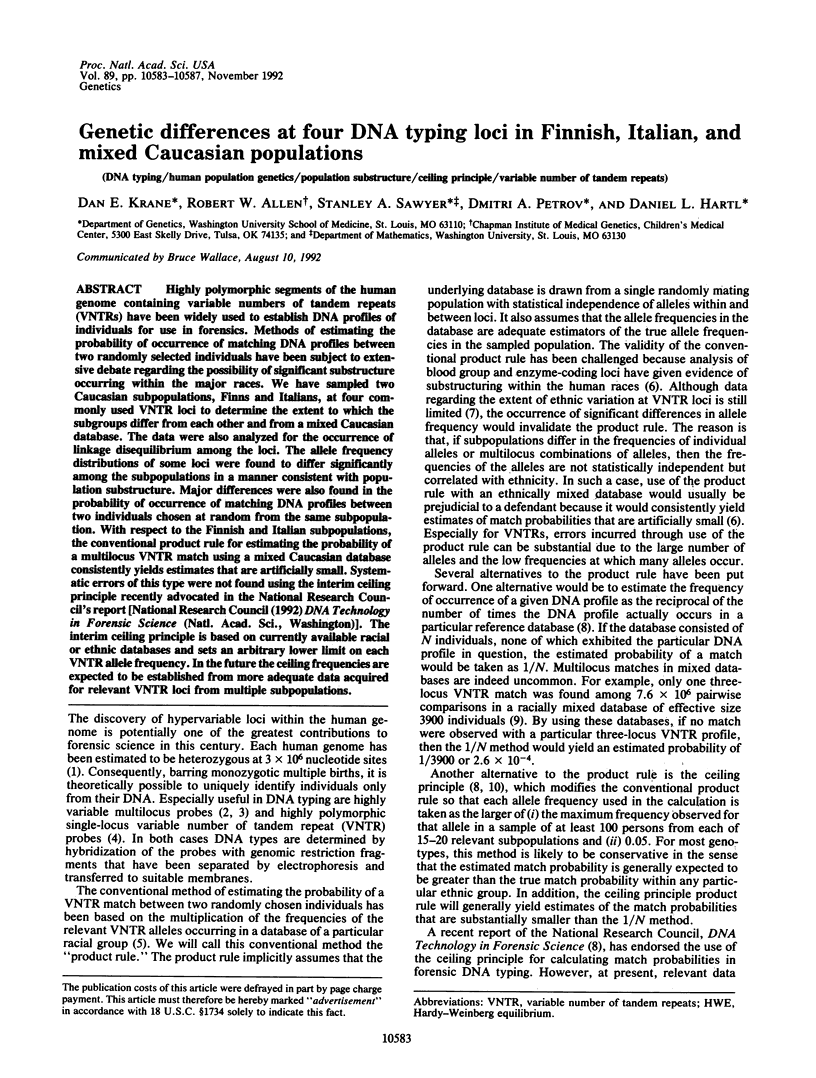
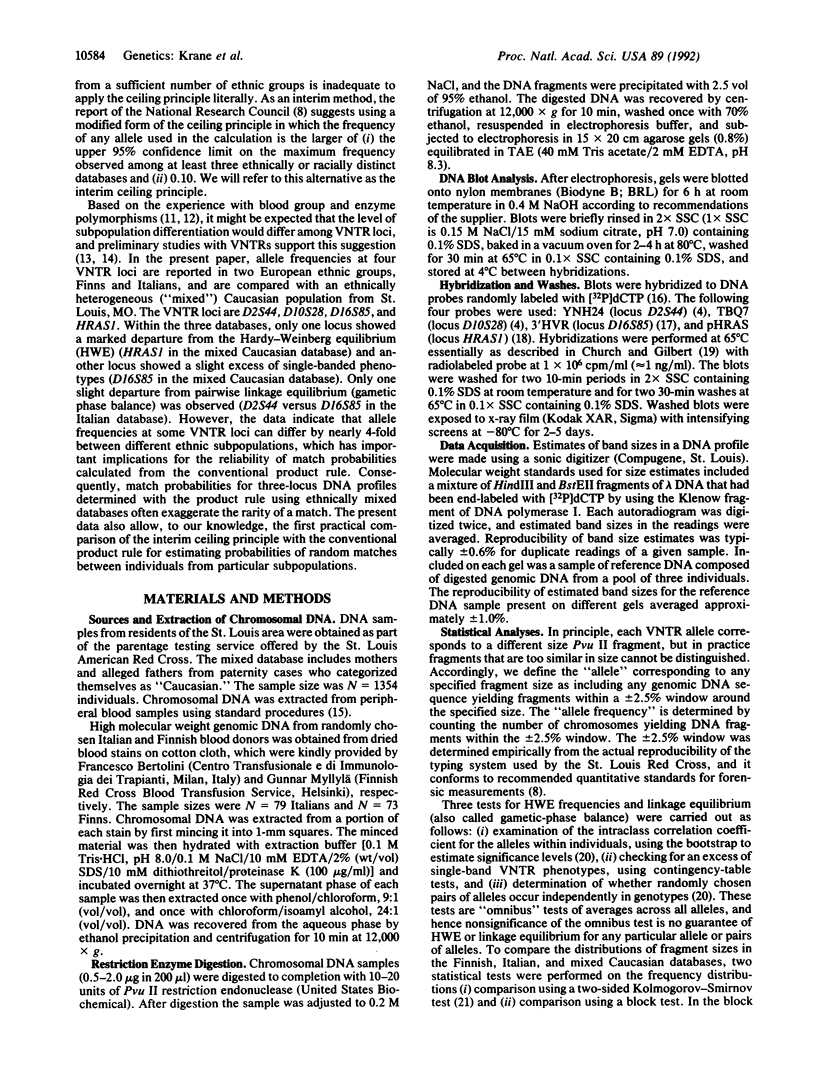
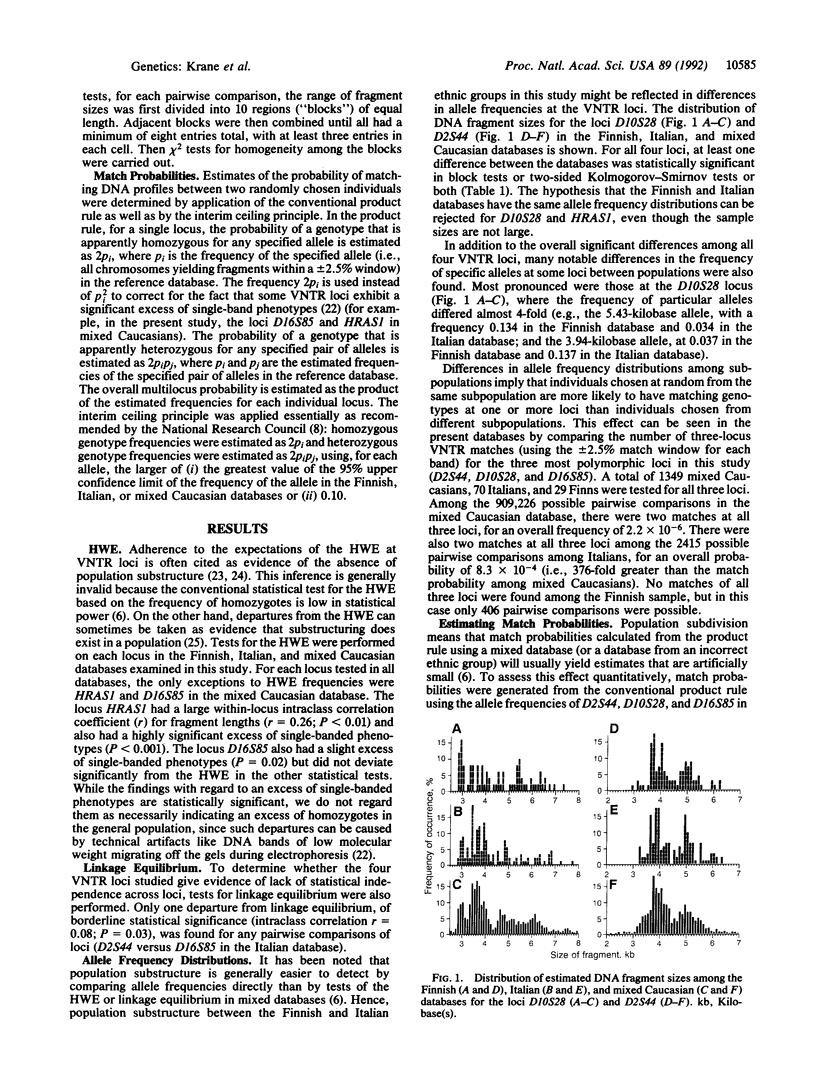
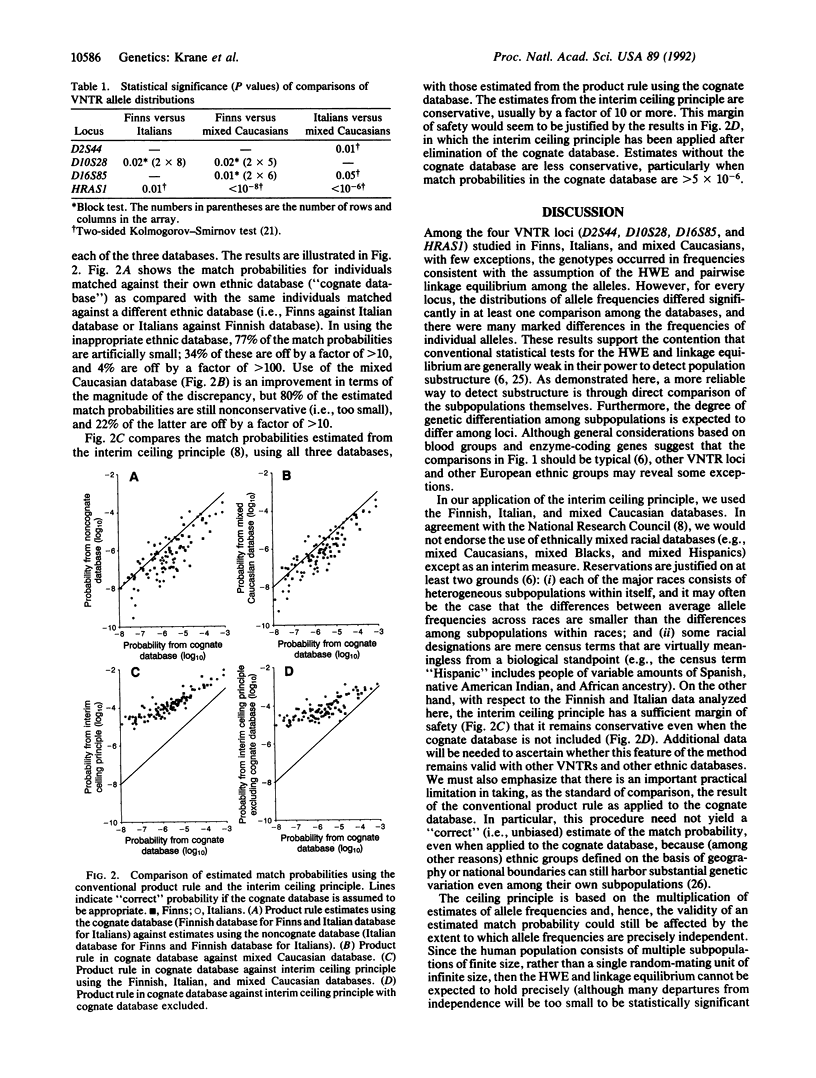
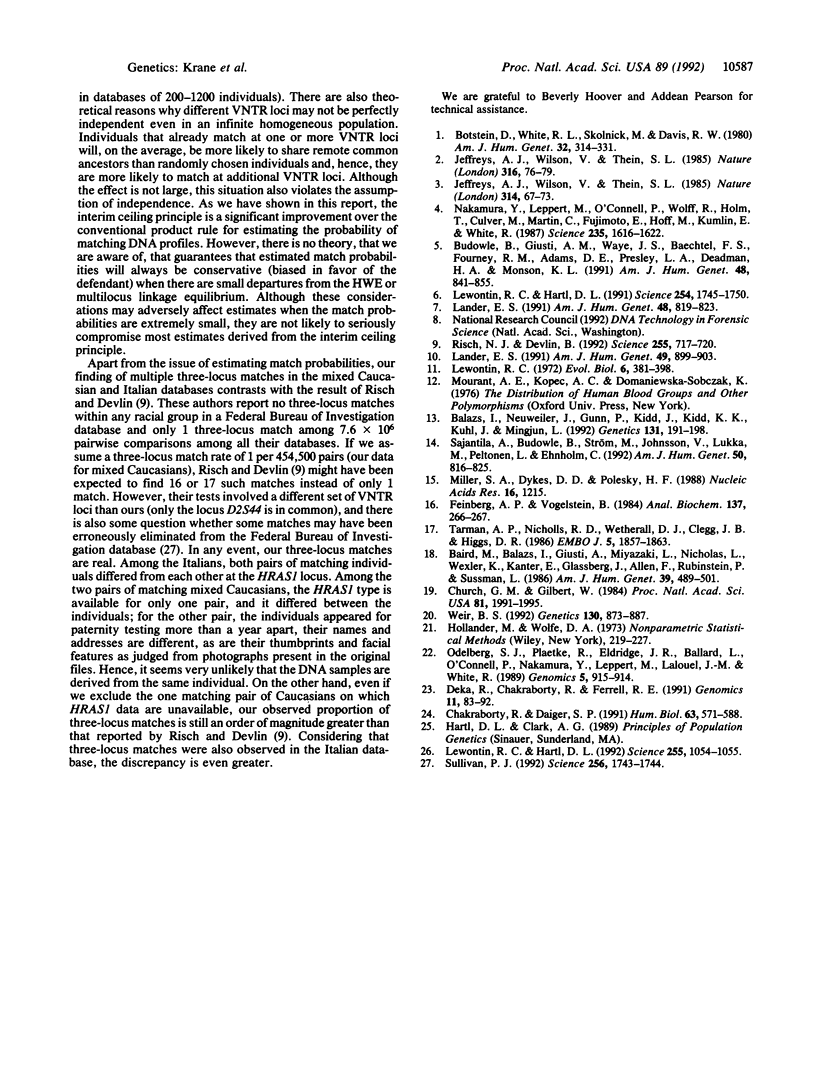
Images in this article
Selected References
These references are in PubMed. This may not be the complete list of references from this article.
- Baird M., Balazs I., Giusti A., Miyazaki L., Nicholas L., Wexler K., Kanter E., Glassberg J., Allen F., Rubinstein P. Allele frequency distribution of two highly polymorphic DNA sequences in three ethnic groups and its application to the determination of paternity. Am J Hum Genet. 1986 Oct;39(4):489–501. [PMC free article] [PubMed] [Google Scholar]
- Balazs I., Neuweiler J., Gunn P., Kidd J., Kidd K. K., Kuhl J., Mingjun L. Human population genetic studies using hypervariable loci. I. Analysis of Assamese, Australian, Cambodian, Caucasian, Chinese and Melanesian populations. Genetics. 1992 May;131(1):191–198. doi: 10.1093/genetics/131.1.191. [DOI] [PMC free article] [PubMed] [Google Scholar]
- Botstein D., White R. L., Skolnick M., Davis R. W. Construction of a genetic linkage map in man using restriction fragment length polymorphisms. Am J Hum Genet. 1980 May;32(3):314–331. [PMC free article] [PubMed] [Google Scholar]
- Budowle B., Giusti A. M., Waye J. S., Baechtel F. S., Fourney R. M., Adams D. E., Presley L. A., Deadman H. A., Monson K. L. Fixed-bin analysis for statistical evaluation of continuous distributions of allelic data from VNTR loci, for use in forensic comparisons. Am J Hum Genet. 1991 May;48(5):841–855. [PMC free article] [PubMed] [Google Scholar]
- Chakraborty R., Daiger S. P. Polymorphisms at VNTR loci suggest homogeneity of the white population of Utah. Hum Biol. 1991 Oct;63(5):571–587. [PubMed] [Google Scholar]
- Church G. M., Gilbert W. Genomic sequencing. Proc Natl Acad Sci U S A. 1984 Apr;81(7):1991–1995. doi: 10.1073/pnas.81.7.1991. [DOI] [PMC free article] [PubMed] [Google Scholar]
- Deka R., Chakroborty R., Ferrell R. E. A population genetic study of six VNTR loci in three ethnically defined populations. Genomics. 1991 Sep;11(1):83–92. doi: 10.1016/0888-7543(91)90104-m. [DOI] [PubMed] [Google Scholar]
- Feinberg A. P., Vogelstein B. "A technique for radiolabeling DNA restriction endonuclease fragments to high specific activity". Addendum. Anal Biochem. 1984 Feb;137(1):266–267. doi: 10.1016/0003-2697(84)90381-6. [DOI] [PubMed] [Google Scholar]
- Jarman A. P., Nicholls R. D., Weatherall D. J., Clegg J. B., Higgs D. R. Molecular characterisation of a hypervariable region downstream of the human alpha-globin gene cluster. EMBO J. 1986 Aug;5(8):1857–1863. doi: 10.1002/j.1460-2075.1986.tb04437.x. [DOI] [PMC free article] [PubMed] [Google Scholar]
- Jeffreys A. J., Wilson V., Thein S. L. Hypervariable 'minisatellite' regions in human DNA. Nature. 1985 Mar 7;314(6006):67–73. doi: 10.1038/314067a0. [DOI] [PubMed] [Google Scholar]
- Jeffreys A. J., Wilson V., Thein S. L. Individual-specific 'fingerprints' of human DNA. Nature. 1985 Jul 4;316(6023):76–79. doi: 10.1038/316076a0. [DOI] [PubMed] [Google Scholar]
- Lander E. S. Research on DNA typing catching up with courtroom application. Am J Hum Genet. 1991 May;48(5):819–823. [PMC free article] [PubMed] [Google Scholar]
- Lewontin R. C., Hartl D. L. Population genetics in forensic DNA typing. Science. 1991 Dec 20;254(5039):1745–1750. doi: 10.1126/science.1845040. [DOI] [PubMed] [Google Scholar]
- Lewontin R. C., Hartl D. L. Response. Science. 1992 Feb 28;255(5048):1053–1054. doi: 10.1126/science.255.5048.1053. [DOI] [PubMed] [Google Scholar]
- Miller S. A., Dykes D. D., Polesky H. F. A simple salting out procedure for extracting DNA from human nucleated cells. Nucleic Acids Res. 1988 Feb 11;16(3):1215–1215. doi: 10.1093/nar/16.3.1215. [DOI] [PMC free article] [PubMed] [Google Scholar]
- Nakamura Y., Leppert M., O'Connell P., Wolff R., Holm T., Culver M., Martin C., Fujimoto E., Hoff M., Kumlin E. Variable number of tandem repeat (VNTR) markers for human gene mapping. Science. 1987 Mar 27;235(4796):1616–1622. doi: 10.1126/science.3029872. [DOI] [PubMed] [Google Scholar]
- Odelberg S. J., Plaetke R., Eldridge J. R., Ballard L., O'Connell P., Nakamura Y., Leppert M., Lalouel J. M., White R. Characterization of eight VNTR loci by agarose gel electrophoresis. Genomics. 1989 Nov;5(4):915–924. doi: 10.1016/0888-7543(89)90134-1. [DOI] [PubMed] [Google Scholar]
- Risch N. J., Devlin B. On the probability of matching DNA fingerprints. Science. 1992 Feb 7;255(5045):717–720. doi: 10.1126/science.1738844. [DOI] [PubMed] [Google Scholar]
- Sajantila A., Budowle B., Ström M., Johnsson V., Lukka M., Peltonen L., Ehnholm C. PCR amplification of alleles at the DIS80 locus: comparison of a Finnish and a North American Caucasian population sample, and forensic casework evaluation. Am J Hum Genet. 1992 Apr;50(4):816–825. [PMC free article] [PubMed] [Google Scholar]
- Sullivan P. J. DNA fingerprint matches. Science. 1992 Jun 26;256(5065):1743–1746. doi: 10.1126/science.1520396. [DOI] [PubMed] [Google Scholar]
- Weir B. S. Independence of VNTR alleles defined as fixed bins. Genetics. 1992 Apr;130(4):873–887. doi: 10.1093/genetics/130.4.873. [DOI] [PMC free article] [PubMed] [Google Scholar]



